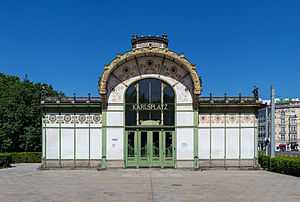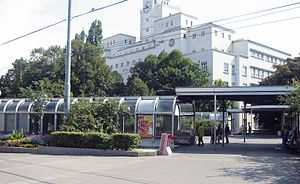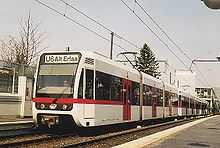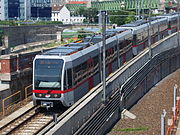Vienna U-Bahn
The Vienna U-Bahn (German: U-Bahn Wien), where U-Bahn is an abbreviation of the German term Untergrundbahn (English: underground railway), is the rapid transit (metro) system for Vienna, Austria. With the October 2013 opening of the 4.2 kilometers (2.6 mi), 3 station extension of the U2 line,[3][4] the five line U-Bahn network consists of 79.1 kilometers (49.2 mi) of route, serving 104 stations.[1] It is the backbone of one of the best performing public transport systems worldwide according to UITP (International Association of Public Transport) in June 2009.[2] More than 1.3 million passengers rode the Vienna U-Bahn every day in 2009,[2] and 567.6 million passengers utilized the U-Bahn in 2011,[5] which declined to 428.8 million passengers in 2013.[1] The network is undergoing expansion and rolling stock renewal. Since 1969, 200 million euros have been invested annually in the extension of the Vienna U-Bahn.[2]
The first section of the modern U-Bahn opened on 8 May 1976, but two of the lines extended and later designated as U-Bahn (U4, U6) date back to the Stadtbahn ("city railway") system, which first opened in 1898. Parts of both the U2 and U6 originate from subway tunnels built to accommodate earlier tram lines. Only the U1 and U3 were built wholly as new subway lines.
Lines are designated merely by a number and the prefix "U" (for U-Bahn) and identified on station signage and related literature by a colour. There are currently five lines; U1, U2, U3, U4 and U6. Since the late 1960s there have been numerous suggestions of routings for a line U5 but all these projects have been shelved, until the construction of a new U5 has been announced in early 2014.[6] Stations are often named after streets, public spaces or districts, and in some special cases after prominent buildings at or near the station, although the official policy of the Wiener Linien states that they prefer not to name stations after buildings.
Ticketing for the network is integrated under the Wiener Linien umbrella brand with all means of public transport in Vienna, including trams and buses. Local tickets are valid on S-Bahn suburban rail services and other train services but these are operated by the state railway operator, ÖBB. Tickets are not valid on bus services operated by Vienna Airport Lines and the City Airport Train express train.

History
Compared to other underground railways worldwide, the Vienna U-Bahn is young. The question of whether to build a Vienna U-Bahn was the subject of heated debate for over one hundred years. From 1844 to the 1960s, numerous mass train transport plans were discussed, ignored or simply rejected.

The first system to be constructed was a 4-line Stadtbahn railway network (originally projected as 3 main and 3 local lines) using steam trains. Ground was broken in 1892, and the system was opened in stages between 11 May 1898 and 6 August 1901. At Hütteldorf, the Stadtbahn connected to railway service to the west, and at Heiligenstadt, to railway service on the Franz Josef Line, which then ran eastwards within the Austro-Hungarian Empire to Eger. Some of the Jugendstil stations for this system designed by Otto Wagner are still in use. However, the Stadtbahn proved inadequate for mass transport, less successful than the tramway. Starting in 1910, plans were considered for an underground system, but were interrupted by the First World War, which also necessitated closing the Stadtbahn to civilian use. After the war, the economic situation of a smaller and poorer country ruled out continuing with the plan. However, starting on 26 May 1924 the Stadtbahn was electrified, something that many had called for before the war, and from autumn 1925 it was integrated with the tramway rather than the railways. The frequency of trains tripled. Plans for a U-Bahn dating to 1912–14 were revived and discussions took place in 1929, but the Great Depression again necessitated abandoning planning.
Both in 1937 and after the Anschluß, when Vienna became the largest city by surface area in the Third Reich, ambitious plans for a U-Bahn, as well as a new central railway station, were discussed. Test tunnelling took place, but these plans, too, had to be shelved when the Second World War broke out.
Severe war damage caused the Stadtbahn system to be suspended in some areas until 27 May 1945. The redevelopment of stations took until the 1950s. Meanwhile, Vienna was occupied by the four allied powers until 1955, and in 1946 had returned three quarters of the pre-war expanded Greater Vienna to the state of Lower Austria. Two proposals for U-Bahn systems were nonetheless presented, in 1953 and 1954. Increasing car traffic led to cutbacks in the S-Bahn network that were partially made up for by buses. The U-Bahn issue was also politicised: in the 1954 and 1959 city council elections, the conservative Austrian People's Party championed construction of a U-Bahn, but the more powerful Social Democratic Party of Austria campaigned for putting housing first. The city council repeatedly rejected the U-Bahn idea in the late 1950s and early 1960s.
Extensions of the Stadtbahn system had always been discussed as an alternative to building a new U-Bahn. But it was not until the late 1960s, when the Stadtbahn and the Schnellbahn were no longer able to adequately serve the ever-increasing public traffic, that the decision to build a new network was taken. On 26 January 1968, the city council voted to begin construction of a 30 km basic network (Grundnetz). Construction began on 3 November 1969[7] on and under Karlsplatz, where three lines of the basic network were to meet, and where central control of the U-Bahn was initially located. Test operation began on 8 May 1976 on line U4, and the first newly constructed (underground) stretch of line opened on 25 February 1978 (five stations on U1 between Reumannplatz and Karlsplatz).
The construction of the Vienna U-Bahn network can be divided into several stages:[2]
Initial construction (1969–1982): Basic network (Grundnetz)

First, the basic network (Grundnetz) was chosen from the various network designs. During 1967, plans for the U2 were radically reduced and the U3 completely deleted, and the approved basic network was described as a 'closer basic network'.[2] This closer basic network, consisting of the U1, U2 and U4 lines, included:
- New route between Reumannplatz and Praterstern
- U2 between Karlsplatz and Schottenring
- U4 between Hütteldorf and Heiligenstadt, consisting almost entirely of modification and adaptation of the existing Stadtbahn line
Construction began on 3 November 1969. On 25 February 1978, the first Vienna U-Bahn route between Karlsplatz and Reumannplatz, the U1, went into operation. With a total of twelve partial commissionings, the Vienna U-Bahn basic network was completed on 3 September 1982.
2nd expansion phase (1982–2000): Lines U3 and U6

The second phase involved the expansion of the U3 and U6 lines (about 61 km, (37.9 mi)). The groundbreaking ceremony for this phase took place on 7 September 1983 on Pottendsdorfer Street at the Philadelphia Bridge and after 6 years, the central section of the U6 between Philadelphia Bridge and Heligenstadt/Friedensbrücke went into operation.
By mid-1990, the U6 had been extended from Siebenhirten to Floridsdorf and the U3 from Simmering to Ottakring constructed.
3rd expansion phase (2001–2010): The first extensions of U1 and U2


In 1996, a new U-Bahn contract, known as the "30 billion package", was settled. For the first time in Europe, a U-Bahn project had to undergo a costly and lengthy environmental impact assessment, as the U2 extension showed a length of more than 10 km (6.2 mi).[2] This expansion phase involved:
U1 extension to Leopoldau
On 19 October 2001, the groundbreaking ceremony for the extension of U1 was held, for which the two districts had been waiting for 20 years.[2] After five years of construction, the 4.6 km (2.9 mi) long extension of the U1 was opened on 2 September 2006.
U2 extension from Schottenring to Stadium
On 12 June 2003, the groundbreaking ceremony took place outside the Stadion (stadium). Due to the 2008 European Football Championships in Austria, there was enormous pressure to complete the construction on time. The Wiener Linien met the deadline, and on 10 May 2008 the U2 extension to the stadium was opened.
U2 extension from Stadium to Aspern
On 2 October 2010, a further six stations were opened taking the U2 across the Danube via Donaustadtbrücke to Aspernstrasse in the twenty-second district (Donaustadt).[8] An additional 4.2 kilometers (2.6 mi), three station extension of the U2 to Aspern Seestadt was officially opened on 5 October 2013.[3][4]
Timeline

| Date | Opening | Closure |
|---|---|---|
| 1976-05-08 | Heiligenstadt – Friedensbrücke | |
| 1978-02-25 | Reumannplatz – Karlsplatz | |
| 1978-04-03 | Friedensbrücke – Schottenring | |
| 1978-08-15 | Schottenring – Karlsplatz (U4) | |
| 1978-11-18 | Karlsplatz – Stephansplatz | |
| 1979-11-24 | Stephansplatz – Nestroyplatz | |
| 1980-08-30 | Karlsplatz – Schottenring (U2) | |
| 1980-10-26 | Karlsplatz – Meidling | |
| 1981-02-28 | Nestroyplatz – Praterstern | |
| 1981-08-31 | Meidling – Hietzing | |
| 1981-12-20 | Hietzing – Hütteldorf | |
| 1982-09-03 | Praterstern – Kagran | |
| 1989-10-07 | Philadelphiabrücke – Heiligenstadt | |
| 1991-04-06 | Erdberg – Volkstheater | |
| 1993-09-04 | Volkstheater – Westbahnhof | |
| 1994-09-03 | Westbahnhof – Johnstraße | |
| 1995-04-15 | Philadelphiabrücke – Siebenhirten | |
| 1996-05-04 | Nussdorfer Straße – Floridsdorf | Nussdorfer Straße – Heiligenstadt |
| 1998-12-05 | Johnstraße – Ottakring | |
| 2000-12-02 | Erdberg – Simmering | |
| 2006-09-02 | Kagran – Leopoldau | |
| 2008-05-10 | Schottenring – Stadion | |
| 2010-10-02 | Stadion – Aspernstraße | |
| 2013-10-05 | Aspernstraße - Seestadt |
U-Bahn network
With the October 2013 opening of the 4.2 kilometers (2.6 mi), 3 station extension of the U2 line,[3][4] the U-Bahn consists of 79.1 kilometers (49.2 mi) of route.[1] With the U2 extension, the five U-Bahn lines (U1-U4 and U6) now serve 104 stations,[1] including nine interchanges. Further extensions of the Vienna U-Bahn are scheduled to be completed by 2019. Upon completion, there will then be a network that is 90 kilometers (56 mi) long with 116 stations.[2] Some plans have been proposed for the system beyond 2019, although such plans are currently unfunded.
U-Bahn services run between 5 am and around 1 am at intervals between two and five minutes during the day and up to eight after 8 pm. Since 4 September 2010, there has been a 24-hour service operating at a 15-minute interval in the nights between Fridays - Saturdays, Saturdays - Sundays and in the nights prior to a public holiday. The 24-hour U-Bahn is supplemented in these nights by Vienna NightLine bus services.
| Line | Colour | Route | Length | Stations |
|---|---|---|---|---|
| U1 | red | Reumannplatz – Leopoldau | 14.6 km (9.1 mi) | 19 |
| U2 | purple | Karlsplatz – Seestadt | 16.7 km (10.4 mi) | 20 |
| U3 | orange | Ottakring – Simmering | 13.5 km (8.4 mi) | 21 |
| U4 | green | Hütteldorf – Heiligenstadt | 16.5 km (10.3 mi) | 20 |
| U6 | brown | Siebenhirten – Floridsdorf | 17.4 km (10.8 mi) | 24 |
Stations
Line U1


- Reumannplatz (25 February 1978)
- First new station opened
- Keplerplatz (25 February 1978)
- Südtiroler Platz-Hauptbahnhof (25 February 1978)
- Connection underground to S-Bahn and trams
- Taubstummengasse (25 February 1978)
- Karlsplatz (25 February 1978)
- Connections to U2, U4, and local trains
- U4 station on the site of 1898 Stadtbahn station and incorporating parts of it
- Complex design because River Wien flows underground between the U2 and U4 platforms
- Has more escalators than any other station in system
- Stephansplatz (18 November 1978)
- Connection to U3
- Vergilius Chapel is within the station
- Schwedenplatz (24 November 1979)
- Connection to U4
- Formerly Stadtbahn station (1901)
- Remnants of the ancient city walls visible
- Nestroyplatz (24 November 1979)
- Praterstern (28 February 1981)
- Connections to U2, mainline and S-Bahn
- Originally built with branch-off of Line U1A in view; U2 was built instead
- Vorgartenstraße (3 September 1982)
- Connection to Donaudampfschiffahrtsgesellschaft
- Donauinsel (3 September 1982)
- Station is on lower level of Reichsbrücke
- Kaisermühlen / Vienna International Centre (3 September 1982)
- Alte Donau (3 September 1982)
- Kagran (3 December 1982)
- Name changed from Zentrum Kagran ("Kagran Centre") to avoid confusion
- Kagraner Platz (2 September 2006)
- Rennbahnweg (2 September 2006)
- Aderklaaer Straße (2 September 2006)
- Großfeldsiedlung (2 September 2006)
- Leopoldau (2 September 2006)
- Connections to mainline and S-Bahn.
Line U2

- Seestadt (5 October 2013)
- Aspern Nord (5 October 2013)
- Hausfeldstraße (5 October 2013)
- Connection to local trains
- Aspernstraße (2 October 2010)
- Donauspital (2 October 2010)
- Hardeggasse (2 October 2010)
- Stadlau (2 October 2010)
- Connection to S-Bahn
- Donaustadtbrücke (2 October 2010)
- Donaumarina (2 October 2010)
- Stadion (10 May 2008)
- 3 tracks, 2 symmetrical inside platforms
- Krieau (10 May 2008)
- Until 2006, station was to be named Trabrennstraße
- Messe-Prater (10 May 2008)
- Praterstern (10 May 2008 – U1 station 1981)
- Connections to U1, main line and S-Bahn
- Taborstraße (10 May 2008)
- Schottenring (10 May 2008; 1980 terminus, with different platform layout)
- Connection to U4; that part of station converted from 1901 Stadtbahn station
- Station is located under the Donaukanal
- Schottentor (30 August 1980)
- Rathaus (30 August 1980)
- Station opened 1965 as Friedrich-Schmidt-Platz on the U-Straßenbahn underground tramway
- Volkstheater (30 August 1980)
- Connection to U3
- Station opened 1965 as Burggasse on the U-Straßenbahn underground tramway
- Museumsquartier (30 August 1980)
- Station features public art
- Opened 1965 as Mariahilfer Straße on the U-Straßenbahn underground tramway
- Karlsplatz (30 August 1980; U1 25 February 1978)
- Connections to U1, U4, and local trains
- U4 station on the site of 1898 Stadtbahn station and incorporating parts of it
- Complex design because River Wien flows underground between the U2 and U4 platforms
- Has more escalators than any other station in system.
Line U3

- Ottakring (5 December 1998)
- Connection to S-bahn
- Kendlerstraße (5 December 1998)
- Hütteldorfer Straße (5 December 1998)
- Johnstraße (3 September 1994)
- Schweglerstraße (3 September 1994)
- Station features public art
- Westbahnhof (4 September 1993)
- Connections to U6, mainline and S-bahn
- Public art in parts of passageways
- U6 station, opened 1989, is in 1898 Stadtbahn station
- Zieglergasse (4 September 1993)
- Stacked platforms: trains to Simmering above trains to Ottakring
- Neubaugasse (4 September 1993)
- Stacked platforms: trains to Simmering above trains to Ottakring
- Volkstheater (6 April 1991; U2 since 1980)
- Connection to U2
- Station features public art
- Herrengasse (6 April 1991)
- Stephansplatz (6 April 1991; U1 1978)
- Connection to U1
- Stacked platforms: trains to Simmering above trains to Ottakring
- Stubentor (6 April 1991)
- Stacked platforms: trains to Simmering above trains to Ottakring
- Remains of ancient city walls
- Landstraße (6 April 1991)
- Connections to U4, mainline, S-Bahn and City Airport Train
- U4 station is in 1899 Stadtbahn station
- Rochusgasse (6 April 1991)
- Kardinal-Nagl-Platz (6 April 1991)
- Schlachthausgasse (6 April 1991)
- Erdberg (6 April 1991)
- Central control and maintenance facility; track branch to U2
- Gasometer (2 December 2000)
- Zippererstraße (2 December 2000)
- Enkplatz (2 December 2000)
- Simmering (2 December 2000)
- Connections to mainline and S-Bahn
Line U4

- Hütteldorf (20 December 1981)
- Connections to mainline and S-Bahn
- Was the Hütteldorf-Hacking station on the Stadtbahn
- Otto Wagner’s design partially retained
- Ober St. Veit (20 December 1981)
- Otto Wagner’s design partially retained
- Unter St. Veit (20 December 1981)
- Braunschweiggasse (20 December 1981)
- Hietzing (31 August 1981)
- Otto Wagner’s Hofpavillon, 1899 Stadtbahn station for the use of the Imperial family, is at one end of the inward-bound platform
- Schönbrunn (31 August 1981)
- Otto Wagner’s design largely retained
- Meidling Hauptstraße (26 October 1980)
- Extra-wide platform used to accommodate a third track for terminus of Stadtbahn lines G/GD from 1980 to 1985
- Längenfeldgasse (7 October 1989)
- Connection to U6; station was originally not a U4 station
- Margaretengürtel (26 October 1980)
- Otto Wagner’s design partially retained
- Pilgramgasse (26 October 1980)
- Otto Wagner’s design partially retained
- Kettenbrückengasse (26 October 1980)
- Otto Wagner’s design partially retained
- Karlsplatz (15 August 1978)
- Connections to U1, U2, and local trains
- Station retains parts of 1898 Stadtbahn station
- Complex design because River Wien flows underground between the U2 and U4 platforms
- Has more escalators than any other station in system
- Stadtpark (15 August 1978)
- Station in open cut within the park; landmark building by Otto Wagner, opened 30 July 1899, retained
- Landstraße (15 August 1978)
- Connections to U3, mainline, S-Bahn and City Airport Train
- 1899 Stadtbahn station retained
- Tabak (tobacconist) on platform
- Schwedenplatz (15 August 1978)
- Connection to U1
- Schottenring (3 April 1978)
- Connection to U2
- Extra-wide platform used to accommodate two tracks of line U2 from 1980 to 2008
- Rossauer Lände (3 April 1978)
- Otto Wagner’s design partially retained
- Friedensbrücke (8 May 1976)
- Otto Wagner’s design partially retained; from 1978 until 1991 terminus of Stadtbahn/U6
- Spittelau (7 October 1995)
- Connections to U6, mainline and S-Bahn; no previous Stadtbahn or U-Bahn service
- Heiligenstadt (8 May 1976)
- Connections to mainline and S-Bahn
- Until 1989 terminus of Stadtbahn line G
- Otto Wagner’s design partially retained
- Until 1996 terminus of U6.
Line U6

- Siebenhirten (15 April 1995)
- Perfektastraße (15 April 1995)
- Erlaaer Straße (15 April 1995)
- Alterlaa (15 April 1995)
- Am Schöpfwerk (15 April 1995)
- Tscherttegasse (15 April 1995)
- Bahnhof Meidling (7 October 1989)
- Connections to mainline, S-Bahn and local trains
- Niederhofstraße (7 October 1989)
- Längenfeldgasse (7 October 1989)
- Connection to U4
- Gumpendorfer Straße (7 October 1989)
- Historic 1898 Otto Wagner station retained
- Westbahnhof (7 October 1989)
- Connections to U3, mainline and S-bahn
- Public art in parts of passageways
- Burggasse – Stadthalle (7 October 1989)
- Platforms in open cut, now under Central Library
- Otto Wagner’s design partially retained
- Thaliastraße (7 October 1989)
- Opened 1980 as Stadtbahn station
- Josefstädter Straße (7 October 1989)
- Historic 1898 Otto Wagner station retained
- Alser Straße (7 October 1989)
- Historic Otto Wagner station retained
- Michelbeuern (7 October 1989)
- Location of railyard since 1898; rail connection to S-Bahn
- Währinger Straße – Volksoper (7 October 1989)
- Historic Otto Wagner station retained
- Nussdorfer Straße (7 October 1989)
- Historic Otto Wagner station retained
- Spittelau (4 May 1996)
- Connections to U4, mainline and S-Bahn
- Jägerstraße (4 May 1996)
- Dresdner Straße (4 May 1996)
- Handelskai (4 May 1996)
- Connections to mainline and S-Bahn
- Neue Donau (4 May 1996)
- Floridsdorf (4 May 1996)
- Connections to mainline and S-Bahn
- First station on site 1897, current station is rebuilding of S-Bahn terminus.
Projected expansion
4th expansion phase (2010–2017): Further extension of the Vienna U-Bahn

Planning for a fourth U-Bahn expansion phase began in 2001 and concrete ideas were put forth in the 2003 Transport Master Plan.[2] Two projects have been approved:
- U2 extension from Aspernstrasse to Flugfeld Aspern. The former airfield at Aspern is transforming in three major stages into the "Lakeside City" of Vienna. Completion and opening of this extension to Aspern took place on 5 October 2013.[3][4]
- U1 extension, 4.6 kilometers (2.9 mi) from Reumannplatz to Oberlaa. Completion is scheduled for 2017.[9]
5th expansion phase
In the current rail network contract, design work for the next decade has been considered and approved.[2] There are discussions about the 5th expansion phase concerning an extension of the U6 northwards from Floridsdorf.[2] The traffic problems at the city entrances also require consideration of whether to extend the U-Bahn to the edge of the city or beyond.
Rolling stock
The Vienna U-Bahn has three types of rolling stock, as well as maintenance of way equipment. The U1, U2, U3, and U4 have two types of rolling stock: The older U/U1/U2 type (introduced in 1972) and the newer V type (introduced in 2002). The U6 has one class of train, the T/T1 type (introduced in 1993), the older E6/C6 having been retired in 2008 and which now mostly operate in Utrecht in the Netherlands and Kraków in Poland, with a single set being preserved at the Vienna Streetcar Museum.
-
Type U at Stadtpark
-
Type U1 crossing the "Alte Donau" (Old Danube)
-
Type U2 at Ottakring
-
Interior of a Type U1 train
-

Type V approaching Aderklaaer Straße
-
Interior of a Type V train
-

Type E6/C6 crossing a bridge over the Wienzeile
-

Type T at Tscherttegasse
-
Type T1 at Längenfeldgasse
-
Interior of a Type T1 train
Art
In common with many urban transit systems, the Vienna U-Bahn has art works in stations. These include:
- Erdberg: Mosaics Stadteinwärts and Stadtauswärts by Peter Atanasov
- Hütteldorfer Straße: U-BauAlphabet by Georg Salner
- Johnstraße: übertragung by Michael Schneider
- Karlsplatz: Pi by Ken Lum
- Karlsplatz: Spatial installation by Peter Kogler
- Karlsplatz: Frieze Unisono di colori by Ernst Friedrich und Eleonor Friedrich
- Landstraße: E-mail wall by Oswald Oberhuber
- Landstraße: Planet der Pendler mit den drei Zeitmonden by Kurt Hofstetter
- Laurenzgasse: Mural by Heimo Zobernig
- Museumsquartier: Lauf der Geschöpfe, Der Jubilierende, Wächter, Lebenskeim and Tor des Verborgenen by Rudi Wach
- Ottakring: U-Turn by Margot Pilz
- Ottakring: Graffiti wall by Wiener Graffiti Union
- Praterstern: Einen Traum träumen und ihn mit anderen teilen ... by Susanne Zemrosser
- Schottentor: varying installations in glass case
- Schweglerstraße: Kunst der Technik by Nam June Paik
- Stadlau: Nepomuk by Werner Feiersinger
- Stubentor: Bewegungen der Seele by Michael Hedwig
- Südtiroler Platz - Hauptbahnhof: SUED by Franz Graf
- Taborstraße: ein Garten (zum Beispiel) by Ingeborg Strobl
- Volkstheater: Das Werden der Natur by Anton Lehmden
- Westbahnhof: Cirka 55 Schritte durch Europa by Adolf Frohner
- Zippererstraße: Kid's Kunst - Mobilität im kommenden Jahrtausend (children's art)
- Rochusgasse: Roman archaeological remains
See also
References
Inline references
- ↑ 1.0 1.1 1.2 1.3 1.4 1.5 1.6 1.7 1.8 1.9 "Unternehmensprofil - Zahlen, Daten, Fakten" [Company Profile - Figures, Data, Facts] (in German). Wiener Linien. 2015. Retrieved 2015-03-10.
- ↑ 2.0 2.1 2.2 2.3 2.4 2.5 2.6 2.7 2.8 2.9 2.10 2.11 Hödl, J: Das Wiener U-Bahn-Netz, Wiener Linien, 2009.
- ↑ 3.0 3.1 3.2 3.3 "U2 auf verlängerter Strecke unterwegs" [U2 Route Extended] (in German). Wiener Linien. 6 October 2013. Retrieved 2014-04-05.
- ↑ 4.0 4.1 4.2 4.3 "U2-Verlängerung eröffnet" [U2 extension opened] (in German). ORF Wien. 5 October 2013. Retrieved 2014-03-09.
- ↑ "Alles über uns: Betriebsangaben 2011" (PDF) (in German). Wiener Linien. 2012.
- ↑ "Stadt fixiert Trassen von U2 und U5" (in German). ORF Wien. Retrieved 2014-08-02.
- ↑ "U-Bahn-Bau feiert 40. Geburtstag" (in German). ORF Wien. Retrieved 2010-05-31.
- ↑ "Wiener Linien opens U2 extension". Railway Gazette International. 16 October 2010. Retrieved 2013-10-09.
- ↑ "Wien metro line U1 to be extended to Oberlaa". Railway Gazette International. Retrieved 2012-04-03.
Books
- German
- Johann Hödl: Das Wiener U-Bahn Netz, Wiener Linien, 2009
- Johann Walter Hinkel: U-Bahnen von 1863 bis 2010, N.J. Schmid Verlagsgesellschaft, 2004
External links
| Wikimedia Commons has media related to Vienna U-Bahn. |
| ||||||||
| ||||||||||||||||||||||||||
| ||||||









